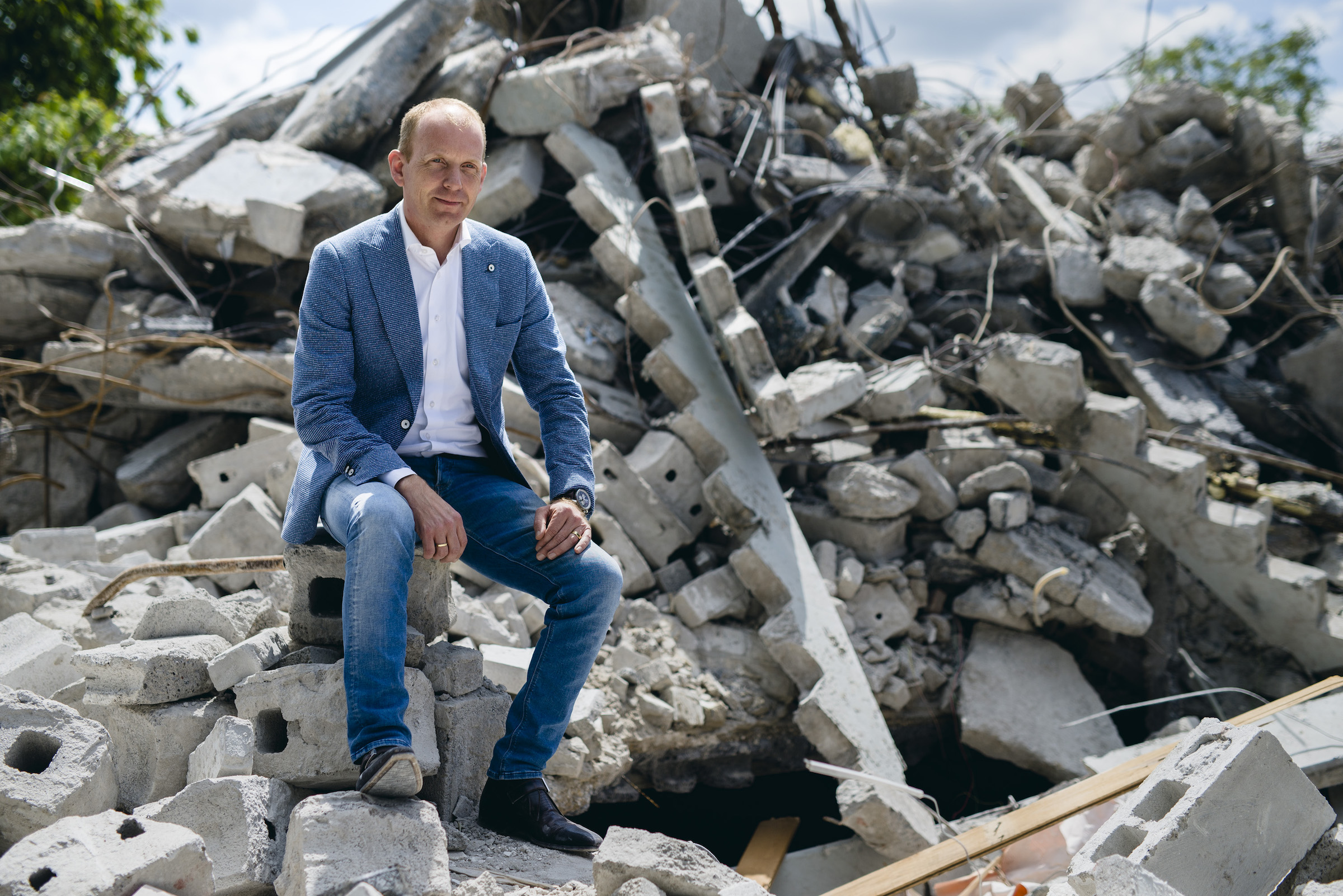Later this year, construction is scheduled to begin on a 115-apartment elder care center for a large healthcare company in Amsterdam, The Netherlands. The project’s developer, REBORN, is working with New Horizon Urban Mining, a demolition firm that specializes in circularity, the practice of deconstructing buildings and infrastructure and selling the building products and components for reuse in new construction.
In this case, the recycled materials come from a 1990s-era Dutch National Bank office building—known locally for its shape as the “cigarette lighter”—that didn’t fit into a planned redevelopment and was torn down. Its remnants—including, prominently, interior glass and plasterboard—will have a second life as parts of other buildings, as will the 14-story tower’s glass façade, which New Horizon removed and loaded onto barges to ship to a warehouse seven miles from the jobsite.
Nearly half of the waste in the Netherlands comes from construction and demolition, yet only a minuscule portion of that waste—around 4%—is reused for residential or nonresidential building. The country, though, has set an ambitious goal to be waste-free by 2050, and Amsterdam itself plans to be building 20% of its new housing with wood and bio-based materials by 2025, and reducing by half its use of raw materials by 2030, according to the New York Times.
Construction and development firms have been debating the efficacy of a circular or regenerative economy for decades. That concept has gotten a lot more attention lately as the construction industry strives to curb the enormous waste it generates—by some estimates, one-quarter of the total waste stream in the U.S. alone—and its carbon footprint that currently accounts for nearly two-fifths of the world’s CO2 emissions.
Michel Baars, who founded New Horizon in 2015, says he introduced the so-called cradle-to-cradle circularity model to the Dutch real estate industry when he co-owned an engineering/inspection consulting firm that was a leader in surveying and management for demolition projects. After selling that company, he recalls, “I realized I wanted to make more of an impact.” He launched New Horizon as a “risk-bearing” company for the demolition of buildings, as well as the production and distribution of building materials from “urban mining.”
Construction materials donations solicited
His 23-employee company generates 15 million Euros (US$15.8 million) in annual revenue. On average, New Horizon demolishes 500 houses and 200,000 sm of commercial buildings such as offices and hospitals per year. New Horizon’s clientele for recycled materials is building owners and developers. When BD+C interviewed Baars by email in November and December, he said his inventory from demolition was “sold out." "Our main goal is scaling up, [so] we need more demolition projects,” he added.
To keep the supply pipeline flowing, Baars says New Horizon offers discounts on the cost of demolition to clients that agree to purchase recycled building products from his company and donate their demo waste to New Horizon. Baars adds, parenthetically, that rarely are clients purchasing the same materials that come from their own demo projects. “We exchange between projects and clients,” he says.
Baars doesn’t believe in owning warehouse space, so he’s worked out deals with big producers and distributors to store New Horizon’s building materials from urban mining in the same warehouses that these companies stock their own products. As the percentage of urban-mined materials becomes larger, New Horizon can more comfortably guarantee full deliveries to contractors, and even offer what Baars calls “hybrid” deliveries that combined urban-mined and newly produced materials.
To demolish buildings in ways that leave materials retrievable and reusable, New Horizon trains its employees and partners itself. An important part of this process, Baars explains, is an analysis of the buildings it plans to demolish so that New Horizon can predict its materials yield. “This is the main guideline for our partners and project leaders,” he says.
That effort is “much easier,” Baars adds, when the building being demolished, such as Dutch National’s office tower, had been constructed using prefabricated components. In fact, Baars founded and co-owns another company called The Middle of Our Street, which produces modular circular social houses. “It is the only winning strategy,” he asserts.
Navigating the building carbon footprint conundrum
Baars is convinced that circularity will make recycled building products more attractive to clients in the future because new production will be more expensive due to carbon taxes. For example, extracting and reusing gypsum from a building’s plaster significantly reduces a project’s carbon footprint because it cuts down on the amount of new gypsum that needs to be manufactured. (Baars says his method of recovery doesn’t crush the plasterboard, so it can be reused in new construction or renovation as wall systems without releasing embodied carbon.)
New Horizon also avoids most CO2 emissions associated with concrete production by reducing chunks of old concrete to a mix that can be separated into cement dust, sand, or gravel. The machines that do this are powered by solar energy, and New Horizon markets the biproduct as climate-neutral.
The company provides 150,000 cubic meters of concrete to the Netherlands’ building industry, and 250,000 tons of other materials that include sand and stone. It is working with Rutte Group, a Dutch company that specializes in circular solutions, to supply concrete for a 300-million-Euro project to repair Amsterdam’s canal walls. The building material is made from recycled content and canal water, and produced onsite.
In the coming years, Baars sees growth for New Horizon Urban Mining coming from its concrete upcycling activities.
“The impact of this materials loop, including the upcycling of ceramic materials, is big enough to make our demolition proposition highly competitive,” he says. And the bigger the scale of his demolition business, the greater the possibilities for urban mining and recycling opportunities in other materials.
Related Stories
AEC Innovators | Mar 2, 2023
Turner Construction extends its ESG commitment to thwarting forced labor in its supply chain
Turner Construction joins a growing AEC industry movement, inspired by the Design for Freedom initiative, to eliminate forced labor and child labor from the production and distribution of building products.
Multifamily Housing | Mar 1, 2023
Multifamily construction startup Cassette takes a different approach to modular building
Prefabricated modular design and construction have made notable inroads into such sectors as industrial, residential, hospitality and, more recently, office and healthcare. But Dafna Kaplan thinks that what’s held back the modular building industry from even greater market penetration has been suppliers’ insistence that they do everything: design, manufacture, logistics, land prep, assembly, even onsite construction. Kaplan is CEO and Founder of Cassette, a Los Angeles-based modular building startup.
AEC Tech | Jan 27, 2023
Key takeaways from Autodesk University 2022
Autodesk laid out its long-term vision to drive digital collaboration through cloud-based solutions and emphasized the importance of connecting people, processes and data.
AEC Tech Innovation | Jan 24, 2023
ConTech investment weathered last year’s shaky economy
Investment in construction technology (ConTech) hit $5.38 billion last year (less than a 1% falloff compared to 2021) from 228 deals, according to CEMEX Ventures’ estimates. The firm announced its top 50 construction technology startups of 2023.
AEC Tech Innovation | Jan 14, 2023
CES recognizes a Dutch firm’s wearable technology for construction management
The firm’s TokenMe product offers construction managers a real-time crowd- and asset-tracking solution via low-power, location-aware radio and RFID tags and multiple sensors through which data are processed with cloud-based artificial intelligence.
Digital Twin | Nov 21, 2022
An inside look at the airport industry's plan to develop a digital twin guidebook
Zoë Fisher, AIA explores how design strategies are changing the way we deliver and design projects in the post-pandemic world.
Giants 400 | Nov 14, 2022
4 emerging trends from BD+C's 2022 Giants 400 Report
Regenerative design, cognitive health, and jobsite robotics highlight the top trends from the 519 design and construction firms that participated in BD+C's 2022 Giants 400 Report.
Contractors | Nov 14, 2022
U.S. construction firms lean on technology to manage growth and weather the pandemic
In 2021, Gilbane Building Company and Nextera Robotics partnered in a joint venture to develop an artificial intelligence platform utilizing a fleet of autonomous mobile robots. The platform, dubbed Didge, is designed to automate construction management, maximize reliability and safety, and minimize operational costs. This was just one of myriad examples over the past 18 months of contractor giants turning to construction technology (ConTech) to gather jobsite data, manage workers and equipment, and smooth the construction process.
Architects | Nov 10, 2022
What’s new at 173 architecture firms for 2022
More than 295 U.S. architecture and architecture-engineering (AE) firms participated in BD+C's 2022 Giants 400 survey. As part of the Giants survey process, participating firms are asked to describe their most impactful firm innovations and noteworthy company moves in the past 12 months. Here is a collection of the most compelling business and project innovations and business moves from the 2022 Architecture Giants.
40 Under 40 | Oct 19, 2022
Meet the 40 Under 40 class of 2022
Each year, the editors of Building Design+Construction honor 40 architects engineers, contractors, and real estate developers as BD+C 40 Under 40 awards winners. These AEC professionals are recognized for their career achievements, passion for the AEC profession, involvement with AEC industry organizations, and service to their communities.

















